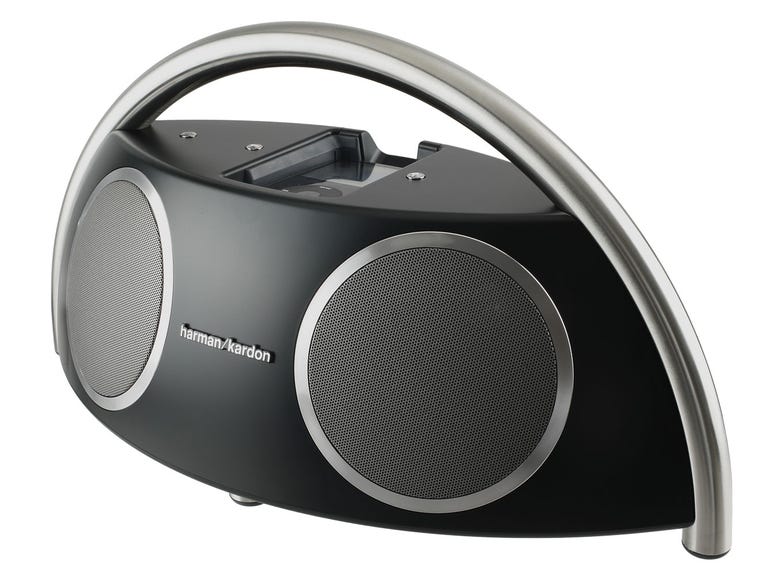 Why You Can Trust CNET
Why You Can Trust CNET Harman/Kardon Go + Play review: Harman/Kardon Go + Play
Harman/Kardon Go + Play
(Editors' note: Harman/Kardon plans to release an updated model of the Go + Play in the spring of 2009 that may address many of the concerns expressed in this review, such as compatibility with recent models of iPods and the iPhone. If you're considering purchasing a Go + Play and you're concerned about device compatibility, we recommend waiting until a new model is released.)
The Good
The Bad
The Bottom Line
The Harman/Kardon Go + Play ($350) is a stunning portable speaker system for the iPod that made its debut in early 2007. After hearing the incredible sound of the Go + Play system, we're kicking ourselves for not getting our hands on it sooner.
Design
The Go + Play's design--like its sound--is hard to ignore. The most notable design elements are the two pairs of bug-eyed, metal speaker grilles placed symmetrically on the front and back of the speaker chassis and a rounded bar of brushed steel that carries the whole thing like some kind of futuristic bowling bag. The Go + Play measures 20 inches wide, 9 inches deep, and 9.5 inches tall, and is raised up slightly by four steel legs with rubber pads that prevent scratching and rattling.
The only buttons on the entire system are for power and volume, located on the top of the matte black speaker enclosure. An elegant, arc-shaped remote control is included, offering extended control for skipping tracks, pausing playback, and jumping through menus. The remote has an outstanding operating range of 30 feet, and uses RF technology that works through walls. When not in use, a pop-out compartment on the back of the Go + Play stores the remote out of sight.
For better or worse, the Go + Play's iPod dock is also located up top, tucked awkwardly beneath the handle. Unlike most iPod speaker systems we see, Harman/Kardon's designers decided to lay the Go + Play's iPod dock horizontally, making it difficult to see your iPod's screen. We're also disappointed that the Go + Play's iPod dock isn't tall enough to fit the iPod Touch or iPhone. The dock's reliance on Firewire voltage also means that many recent generations of iPods won't recharge in the current dock. Harman/Kardon plans to release an updated version of the Go + Play in the spring of 2009 that will address these issues, but until then, the iPhone, iPod Touch, and fourth-generation iPod Nano are poor partners for the system (both iPod Classic models seemed to fit and charge fine, though).

Across the back of the Go + Play are four connections for USB output, AC power input, aux input, and S-Video output. The connections are each covered by flexible rubber flaps that protect against dirt and moisture. On the bottom of the Go + Play you'll find a battery compartment that accommodates 8 D-cell batteries, which can power the system for around 18 to 24 hours. We noticed that the Go + Play's audio playback volume isn't quite as loud using battery power as opposed to the AC adapter, so if your goal is to wake the neighbors, then you're better off plugging into the wall.
Features
The Go + Play isn't much for bells and whistles, and the few features it does include are a little out of date. There's no FM radio, no clock, no LCD to display song titles, and the S-Video output feature isn't compatible with recent iPod models. The USB output is a convenient feature for syncing your docked iPod to a nearby computer, however, as the product's name suggests, the Go + Play is built to be nomadic, not tied down to a computer desk.
If there's one feature to brag about on the Go + Play, it's the exceptional remote control. The included remote has a design that's as equally eye-catching as the speaker it controls, and the RF technology hidden inside allows you to mute, skip, and crank your music with much more freedom than the wimpy IR remotes included with most systems.
Performance
Without a doubt, the Go + Play is the best-sounding portable iPod speaker system we've tested. Held up against systems such as the Altec Lansing iMT702, "="" rel="follow" target="_self">Logitech Pure-Fi Anywhere, the Go + Play blows them all away with greater power, incredibly deep lows, crisp highs and an overall sound quality better than most bookshelf speaker systems in the same price range. With 60 watts of power and an expertly tuned speaker enclosure, the Go + Play is loud enough to fill even the largest room in your house.
The Go + Play even held up well against small, nonportable, high-performance iPod speaker systems, such as the "="" data-link-text="Griffin Amplifi" data-asset-type="review" data-uuid="b24a8bb3-9d89-11e2-853d-0291187978f3" data-slug="griffin-amplifi-speaker-system-w-ipod-dock" rel="follow" target="_self">, and Kicker iK500, pumping out richer, louder sound and looking good while doing it, too. Specifically, the Go + Play offers better low end than the Bose SoundDock, more treble clarity than the Griffin Amplifi, and tighter (but no less dramatic) low frequency performance than the Kicker.
The Go + Play is a powerful little system with quality construction, and a sound that can hold up to the toughest scrutiny, but it comes with a price tag to match. For $350, you could buy a very tasteful little bookshelf system with a CD player, iPod dock, and FM radio. That's not to say the Go + Play doesn't prove its value, but you're dropping a healthy chunk of change for what is ostensibly an iPod boombox. If you like the idea of a battery-powered iPod speaker system, but sound quality and design aesthetics aren't the most important criteria, you could save some serious money going with a system from Altec Lansing, Griffin, or Logitech. And if you're really adventurous, there's always Lasonic.


